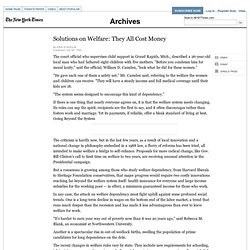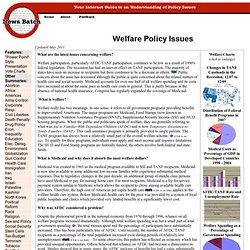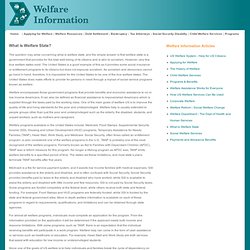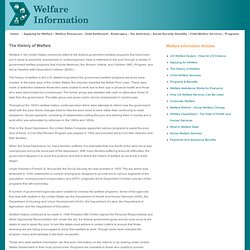

Solutions on Welfare: They All Cost Money. The court official who supervises child support in Grand Rapids, Mich., described a 26-year-old local man who had fathered eight children with five mothers.

"Before you condemn him for moral laxity," said the official, William D. Camden, "look what he did for these women. " "He gave each one of them a safety net," Mr. Camden said, referring to the welfare the women and children can receive. "They will have a steady income and full medical coverage until their kids are 18.
"The system seems designed to encourage this kind of dependency. " If there is one thing that nearly everyone agrees on, it is that the welfare system needs changing. The criticism is hardly new, but in the last few years, as a result of local innovation and a national change in philosophy embodied in a 1988 law, a flurry of reforms has been tried, all intended to make welfare a bridge to self-reliance. In any case, the attack on welfare dependency must fight uphill against some profound social trends. Welfare. What did welfare reform do?

The AFDC program underwent a significant change under Republican-sponsored legislation in 1996 which was signed by President Clinton. States were given far greater latitude in designing their family welfare programs. As the new name implies, TANF can no longer be a lifelong program. All states are required to limit benefits after the expiration of a specified period of time.
Under most state plans, all benefits will be terminated after five years. Each program requires virtually all adult participants to participate in work programs. What has been the effect of welfare reform? In the beginning, the reduction in the number of TANF and Food Stamp recipients surpassed all projections. The degree of TANF reduction has significantly varied from state to state. There has been a dramatic corresponding increase in the percentage of single women with children who are in the labor force. What further reform is being proposed? Is SSI different from Social Security? US Welfare System - Help for US Citizens. The question may arise concerning what is welfare state, and the simple answer is that welfare state is a government that provides for the total well-being of its citizens and is akin to socialism.

However, very few true welfare states exist. The United States is a good example of this as it provides some social insurance or entitlement programs to its citizens but does not espouse socialism. As socialism and democracy cannot go hand in hand, therefore, it is impossible for the United States to be one of the true welfare states. The United States does make efforts to provide for persons in need through a myriad of social service programs known as welfare. Welfare encompasses those government programs that provide benefits and economic assistance to no or low income Americans. Medicaid is a fee for service payment system, and it assists low income families with medical expenses. For almost all welfare programs, individuals must complete an application for the program. US Welfare System - Help for US Citizens.
Welfare in the United States commonly refers to the federal government welfare programs that have been put in place to assist the unemployed or underemployed.

Help is extended to the poor through a variety of government welfare programs that include Medicaid, the Women, Infants, and Children (WIC) Program, and Aid to Families with Dependent Children (AFDC). The history of welfare in the U.S. started long before the government welfare programs we know were created. In the early days of the United States, the colonies imported the British Poor Laws.
These laws made a distinction between those who were unable to work due to their age or physical health and those who were able-bodied but unemployed. US Welfare System - Help for US Citizens.